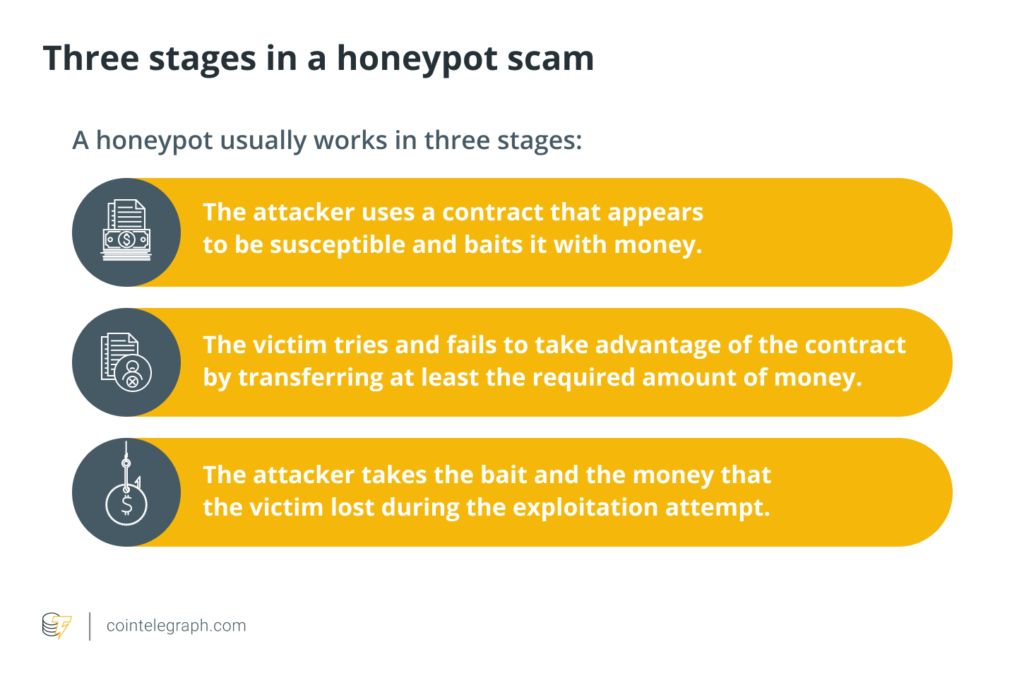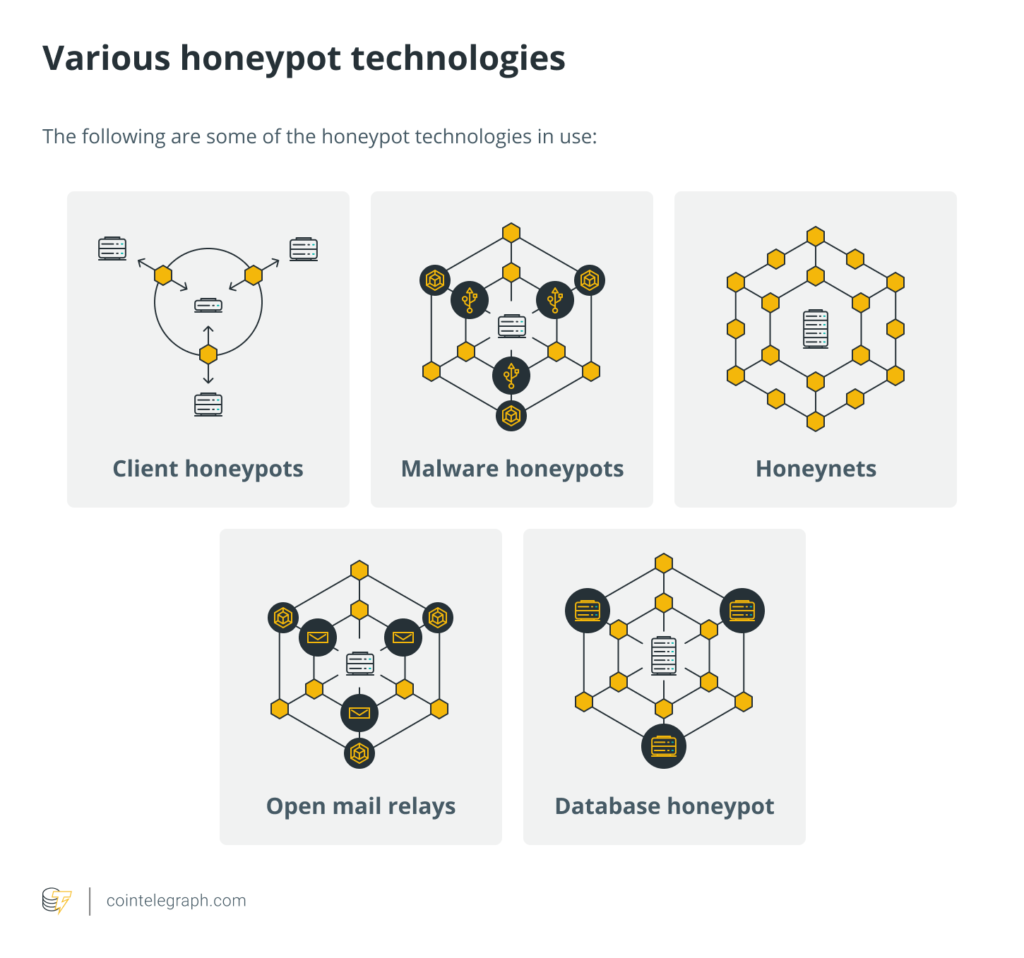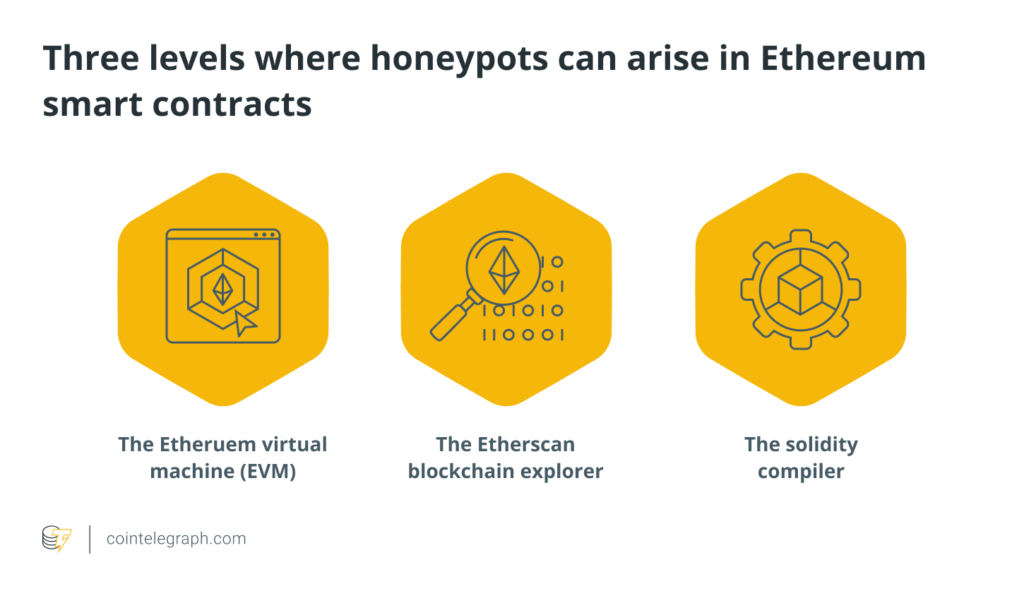What is a honeypot crypto scam and how to spot it?
The word “honeypot” is used to characterize a type of contract. What exactly is a honeypot crypto trap, though?
By Staff
On current blockchains like Ethereum, smart contract programs can be run across a decentralized network of nodes. Smart contracts are growing increasingly popular and expensive, making them a more enticing target for cybercriminals. In recent years, hackers have targeted a number of smart contracts.
However, attackers are now adopting a more proactive tactic rather than seeking for vulnerable contracts. Instead, they send out contracts that appear weak but contain hidden traps in order to deceive their victims into falling into traps. The word “honeypot” is used to characterize this type of contract. What exactly is a honeypot crypto trap, though?
Honeypots are smart contracts with a design flaw that allows an arbitrary user to drain Ether (Ethereum’s native currency) from the contract if the user pays a specific amount of Ether to the contract ahead of time. When the user attempts to exploit this apparent defect, a second, yet undiscovered, trapdoor appears, preventing the ether draining from succeeding. So, what is the purpose of a honeypot?
The goal is for the user to focus solely on the obvious flaw and disregard any indications that the contract has a secondary flaw. Honeypot assaults work because people are routinely duped, just as they are in other types of fraud. As a result, people’s avarice and assumptions make it difficult to measure risk.
How does the honey pot scam work?
The user’s money will be imprisoned in crypto cyber attacks like honeypots, and only the honeypot inventor (attacker) will be able to recover it. In most cases, a honeypot functions in three stages:
- The attacker uses a contract that appears to be susceptible and baits the victim with money.
- The victim tries and fails to take advantage of the contract by transferring at least the required amount of money.
- The attacker takes the bait and the money that the victim lost during the exploitation attempt.
An attacker does not require any special abilities to set up honeypots with Ethereum smart contracts. In reality, an attacker has the same abilities as a regular Ethereum user. They simply require the funds to set up and bait the smart contract. In general, a honeypot operation consists of a computer, applications, and data that simulate the behavior of a real system that can be enticing to attackers, such as Internet of Things devices, banking systems, or public utilities or transit networks.

Despite the fact that it appears to be part of the network, it is separated and monitored. All attempts to communicate with a honeypot are viewed as hostile because legitimate users have no reason to do so. Honeypots are widely used in the demilitarized zone of a network (DMZ). This method keeps it connected while separating it from the leading production network. While attackers access a honeypot in the DMZ, it can be watched from afar, lowering the risk of a compromised main network.
Honeypots can be put outside the external firewall, facing the internet, to detect efforts to enter the internal network. The honeypot’s exact location is determined by its complexity, the type of traffic it seeks to attract, and its proximity to vital corporate resources. Regardless of where it is placed, it will always be isolated from the production environment.
While diverting attackers’ attention away from real-world assets, logging and watching honeypot activity provides information into the degree and types of threats that a network infrastructure faces. Cybercriminals can take over honeypots and use them against the corporation that set them up. Honeypots have also been used by cybercriminals to gather information about researchers or organizations, act as decoys, and spread misinformation.
Virtual machines are widely used to host honeypots. If the honeypot is infected with malware, for example, it can be quickly restored. A honeynet, for example, is a network of two or more honeypots, whereas a honey farm is a centralized collection of honeypots and analysis tools.
Both open source and commercial solutions can help with honeypot setup and administration. Honeypot systems that are offered individually as well as honeypot systems that are supplied in conjunction with other security software and marketed as deception technology are both available. On GitHub, you may get honeypot software that can help newbies learn how to use honeypots.
Types of Honey Pots:
Honeypots based on the design and implementation of smart contracts are divided into two categories: research and production honeypots. Honeypots for study are used to collect information on attacks and assess hostile behavior in the field.

They examine both your environment and the outside world to gather information about attacker trends, vulnerabilities, and malware strains that adversaries are currently targeting. This data can assist you in making decisions about preventative defenses, patch priority, and future investments.
Production honeypots, on the other hand, are designed to detect active network penetration while also misleading the attacker. Honeypots provide additional monitoring possibilities and fill in common detection gaps associated with detecting network scans and lateral movement; hence, data collection remains a primary priority.
Production honeypots run services that would normally run alongside the rest of your production servers in your environment. Honeypots for study are more involved than honeypots for production, because they store more data types.
Depending on the level of sophistication required by your firm, there are several layers within production and research honeypots:
- High-interaction honeypot: Similar to a pure honeypot in that it provides a vast variety of services, but it is less complex and stores less data. Although high-interaction honeypots aren’t meant to be full-scale production systems, they do run (or appear to operate) all of the services often associated with them, including working operating systems.
Using this honeypot form, the deploying organization can observe attacker behaviors and strategies. Honeypots with a high level of engagement need a lot of resources and are difficult to maintain, but the benefits can be worthwhile.

- Mid-interaction honeypots: These resemble the application layer’s properties but lack the operating system. They attempt to obstruct or confuse attackers so that organizations have more time to choose how to respond correctly to an attack.
- Honeypot with low interaction: This is the most common honeypot utilized in a production setting. Low-interaction honeypots provide a few services and are mostly used as a detection tool for early warnings. Because honeypots are easy to set up and maintain, many security teams deploy a large number of them around their network.
- This large-scale, production-like system is run on numerous servers as a pure honeypot. It’s jam-packed with sensors and contains “private” data and user information. Even though it can be complex and difficult to handle, the information they provide is invaluable.
Several honeypot technologies
The following are some of the honeypot technologies in use:

- Client honeypots: The vast majority of honeypots are servers that monitor network traffic. Client honeypots continually monitor the honeypot for any suspicious or unusual changes, as well as malicious servers that target clients. To keep the research team safe, these systems are frequently virtualized and have a containment plan in place.
- Malware honeypots: These detect malware by observing how it replicates and attacks. Honeypots (like Ghost) are designed to resemble USB storage devices. If a machine is afflicted with malware that spreads through USB, for example, the honeypot will trick the infection into infecting the mimicked device.
- Honeynets: Rather than being a single system, a honeynet is a network of numerous honeypots. Honeynets are meant to track an attacker’s actions and motives while keeping all inbound and outgoing communication contained.
- Spam honeypots are used to emulate open mail relays and open proxies. Spammers will test the available mail relay by sending themselves an email. They will send out a massive volume of spam if they are successful. This type of honeypot is capable of detecting and recognizing the test and successfully blocking the ensuing flood of spam.
Because structured query language injections can often go unnoticed by firewalls, some businesses will utilize a database firewall to create fake databases and provide honeypot support.
How to spot a crypto honeypot?
One way to spot a honeypot crypto fraud is to look at the trade history. In principle, a cryptocurrency should allow you to buy and sell it whenever you want. In a honeypot scam, there will be a lot of buyers for the coin, but it will be difficult to sell. This means it’s not a genuine coin, and you should stay away from it.
Furthermore, using a data science method based on contract transaction behavior, contracts can be classified as honeypots or non-honeypots.
Where can honeypots arise in Ethereum smart contracts?
Honeypots could show up in three areas of Ethereum smart contract development. The three tiers are as follows:
- Despite the fact that the Etheruem virtual machine (EVM) adheres to a well-defined set of standards and norms, smart contract writers can present their code in ways that are misleading or ambiguous at first glance. For the unwary hacker, these approaches could be costly.
- The solidity compiler is the second area in which smart contract developers can profit. Some compiler-level defects are well-documented, but others aren’t. Unless the contract has been evaluated in real-world scenarios, these honeypots can be difficult to detect.
- The third type of honeypot is the Etherscan blockchain explorer, which is predicated on the fact that the data offered by blockchain explorers is incomplete. While many people trust Etherscan’s data, it doesn’t always reflect the complete picture. Wily smart contract developers, on the other hand, can take use of some of the explorer’s idiosyncrasies.
How to protect yourself against HoneyPot scammers?
This section will show you how to prevent being a victim of honeypot scams. There are tools that can help you see red flags and steer clear of these currencies. If the currency you’re considering buying is on the Ethereum network, for example, use Etherscan, and if it’s on the Binance Smart Chain, use BscScan.
Determine the Token ID for your coin and enter it on the proper page. On the next screen, click “Token Tracker.” There will be a tab named “Holders.” All of the wallets that contain tokens, as well as the liquidity pools, are visible there. Regrettably, there are many different combinations of objects to be aware of. To protect yourself from honeypot crypto frauds, you should be aware of the following warning flags:
Various ways to protect against honeypot crypto scams
- No dead coins: A project is relatively secure from rug pulls (but not a honeypot) if more than half of the coins are in a dead wallet (usually identified as 0x000000000000000000000000000000000000dead). Be cautious if less than half of the coins are dead or none are dead.
- No audit: If a reputable company audits a honeypot, the possibilities of it being a honeypot are nearly always eliminated.
- Avoid cryptocurrencies using only one or a few wallets if you have a lot of them.
- Examine their website: This should be very basic; but, if the website appears rushed or has poor construction, this is a red flag! To find out when a domain name was registered for a website, go to whois.domaintools.com and enter in the domain name. If the domain was registered within 24 hours or fewer of the project’s commencement, you may be certain it’s a scam.
- Examine their social media accounts: Stolen and low-quality images, grammatical errors, unappealing “spammy statements” (such as “put your ETH address down!”), no connections to relevant project information, and so on are common features of scam projects.
Another great tool for finding honeypot crypto is Token Sniffer. Enter the Token ID in the top right corner to find the “Automated Contract Audit” findings. If there are any alerts, stay away from the project. The “No prior similar token contracts” indicator can be a false positive because many applications now use contract templates.
Go to PooCoin, enter the Token ID again, and keep an eye on the charts if your coin is listed on the Binance Smart Chain. If there aren’t any wallets selling your preferred coin, or if just one or two wallets are selling it, stay away. It’s most likely a honeypot. If several wallets are selling the chosen coin, it isn’t a honeypot. Finally, before parting with your hard-earned cash to buy cryptocurrencies, you should do your homework.
Difference between a honeypot and a honey net.
A honeynet is a collection of two or more honeypots connected by a network. A honeypot network that is connected can be advantageous. It enables companies to monitor how an intruder interacts with a single resource or network point, as well as how an invader moves between network points and interacts with multiple sites at once.
The purpose of the honey net is to persuade hackers that they have successfully entered the network, thus increasing the realism of the setup by adding additional phony network locations. Deception technology refers to honeypots and honeynets with more modern implementations, such as next-generation firewalls, intrusion detection systems (IDSes), and secure web gateways. Intrusion detection systems are devices or software programs that monitor a network for hostile activity or policy violations. Deception technology with automated capabilities allows a honeypot to reply to potential attackers in real-time.
Honeypots can help businesses stay on top of the constantly shifting risk landscape as new cyber threats arise. Honeypots give critical information to assure an organization’s readiness and are possibly the finest way to catch an attacker in the act, despite the fact that no attack can be predicted or prevented. They’re also an excellent resource for cybersecurity specialists.
Pros and Cons of honeypots
Honeypots gather data from real attacks and other illegal conduct, providing analysts with a plethora of information. Furthermore, the number of false positives is reduced. Ordinary cybersecurity detection systems, for example, might produce a large number of false positives, whereas a honeypot reduces the amount of false positives because real users have no need to contact the honeypot.
Honeypots are also worthwhile investments because they only engage with malicious acts and do not necessitate high-performance resources to process massive amounts of network data in search of assaults. Finally, honeypots can detect harmful activity even if an attacker is utilizing encryption.
Honeypots provide a lot of benefits, but they also have a lot of disadvantages and risks. Honeypots, for example, only collect information in the event of an assault. There have been no efforts to gain access to the honeypot, so there is no data to investigate the attack.
Furthermore, the honeypot network only collects harmful traffic when an attack is initiated against it; an attacker who senses a network is a honeypot will avoid it.
Honeypots are easily distinguishable from lawful production systems, implying that expert hackers may use system fingerprinting techniques to quickly distinguish a production system from a honeypot system.
Despite their isolation from the real network, honeypots inevitably connect in some fashion to provide administrators access to the data they contain. A high-interaction honeypot is considered riskier than a low-interaction honeypot since it aims to entice hackers into gaining root access.
Honeypots can help researchers discover hazards in network systems, but they shouldn’t be utilized instead of traditional IDS. If a honeypot isn’t set up properly, for example, it could be used to get access to real-world systems or as a launchpad for attacks on other systems.

